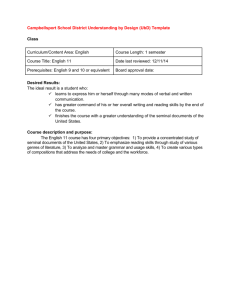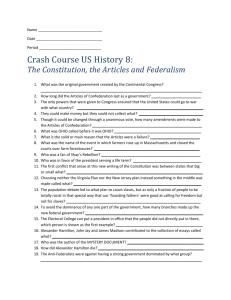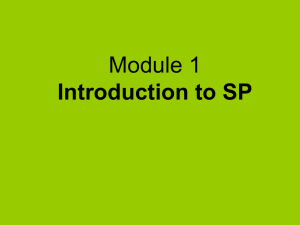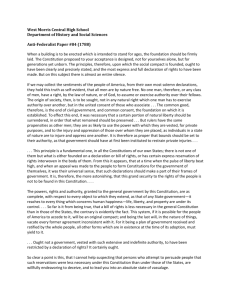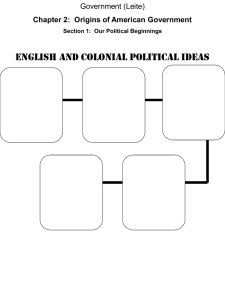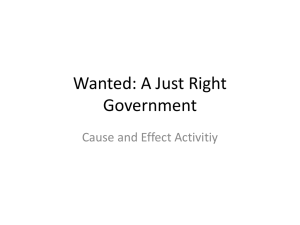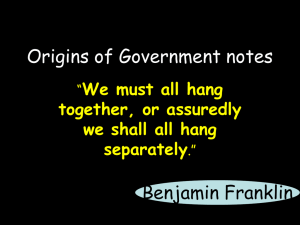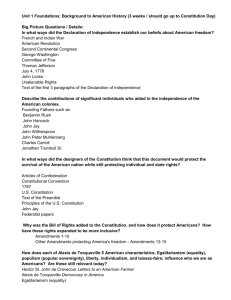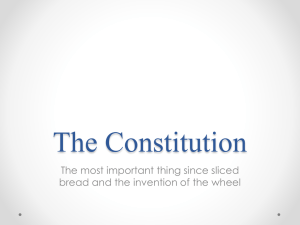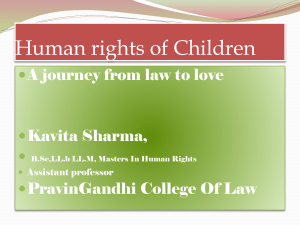Unit Lesson Plan - americanhistoryk
advertisement
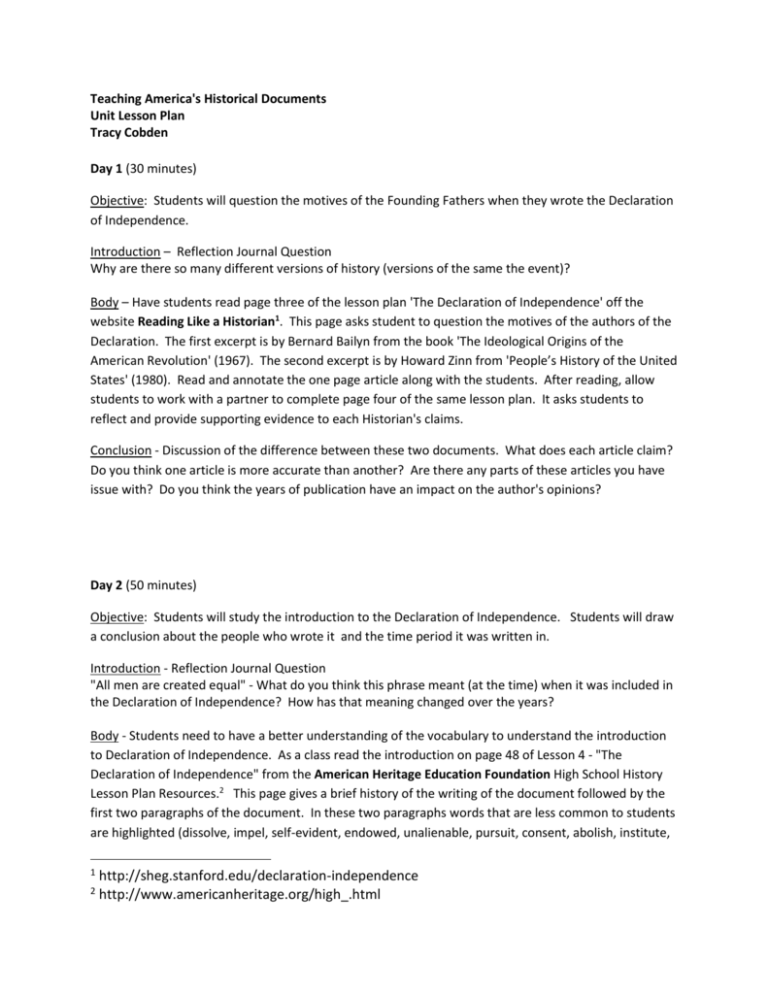
Teaching America's Historical Documents Unit Lesson Plan Tracy Cobden Day 1 (30 minutes) Objective: Students will question the motives of the Founding Fathers when they wrote the Declaration of Independence. Introduction – Reflection Journal Question Why are there so many different versions of history (versions of the same the event)? Body – Have students read page three of the lesson plan 'The Declaration of Independence' off the website Reading Like a Historian1. This page asks student to question the motives of the authors of the Declaration. The first excerpt is by Bernard Bailyn from the book 'The Ideological Origins of the American Revolution' (1967). The second excerpt is by Howard Zinn from 'People’s History of the United States' (1980). Read and annotate the one page article along with the students. After reading, allow students to work with a partner to complete page four of the same lesson plan. It asks students to reflect and provide supporting evidence to each Historian's claims. Conclusion - Discussion of the difference between these two documents. What does each article claim? Do you think one article is more accurate than another? Are there any parts of these articles you have issue with? Do you think the years of publication have an impact on the author's opinions? Day 2 (50 minutes) Objective: Students will study the introduction to the Declaration of Independence. Students will draw a conclusion about the people who wrote it and the time period it was written in. Introduction - Reflection Journal Question "All men are created equal" - What do you think this phrase meant (at the time) when it was included in the Declaration of Independence? How has that meaning changed over the years? Body - Students need to have a better understanding of the vocabulary to understand the introduction to Declaration of Independence. As a class read the introduction on page 48 of Lesson 4 - "The Declaration of Independence" from the American Heritage Education Foundation High School History Lesson Plan Resources.2 This page gives a brief history of the writing of the document followed by the first two paragraphs of the document. In these two paragraphs words that are less common to students are highlighted (dissolve, impel, self-evident, endowed, unalienable, pursuit, consent, abolish, institute, 1 2 http://sheg.stanford.edu/declaration-independence http://www.americanheritage.org/high_.html and principles). Students will work on the vocabulary and a few introductory questions in preparation for tomorrow's lesson. The vocabulary activity asks students to define the word but also use the word in a separate sentence (to check for understanding). Worksheet 1-1 goes with this lesson. Conclusion - No conclusion (lesson continues tomorrow) Day 3 (50 minutes) Objective: Students will determine what prompted the writing of the Declaration of Independence. Students will also examine who the framers where and what their goals were. Introduction - Reflection Journal Question Why might the Declaration of Independence be called the "birth certificate of the United States." Body - Show students the School House Rock on the Declaration of Independence (on Youtube). PowerPoint Notes (Document 1.2) Topics Covered include: Colonies under Colonial Control Stamp Act Heightening Tension Second Continental Congress Writing the Declaration Thomas Jefferson & Constitutional Ideas Who were the signers of the Declaration? There is a student handout (notes sheet and interpretative question) to go along with this PowerPoint. (Document 1.3) Conclusion - Interpret the Image Students will be given a worksheet (Document 1.4) Students will examine an image of Thomas Jefferson, Ben Franklin, and John Adams working on the Declaration of Independence. Students are asked three basic questions. First, what does the image show? Make a list of the basic facts. Second, why might the people be thinking and what might the items have written on them? Students will write comments or thoughts in the appropriate thought bubbles. Third, what connections can you make between the image and modern times? Do our politicians work well together today? If this documents was being written in 2013, would three white men be chosen to write it? Day 4 (20 minute sessions) Objective: Students will examine the complaints the colonists lodge against the king of England. Students will determine if any of these grievances were worth fighting a war over (in their opinion). Introduction - Reflection Journal Question What are some things that make politics more complicated today than they were back in 1787? Body- Pass out page 7 of the lesson plan The Declaration of Independence off the website Reading Like a Historian.3 This page examines some of the grievances against the king as they are stated in the Declaration of Independence. It asks students to determine if the grievances being listed mainly impacted the rich or if they impacted all colonists. This allows for a discussion of the difficulties of writing such a complex document when you are trying to bring in the interest of such a diverse people. How are the issues being addressed things all of the colonists would have issue with? Why was this key when trying to gather widespread support? Conclusion - The questions on the page asks students to reflect on the complaints and if students would find any of these complaints worth going to war over. Collect final questions as an exit ticket. Day 5 (50 minutes) Objective: Students will examine the strengths and weaknesses of the Articles of Confederation. Introduction - Reflection Journal Question Why in times of tragedy are Americans more likely to give up their rights? Body - The Articles of Confederation PPT (Document 1.5) and notes sheet (Document 1.6) Topics Covered Include: What are the Articles of Confederation? When were the Articles written? What powers did the government under the Articles have? What were some of the problems under the Articles? Attempts and Challenges of Change Shays Rebellion Student notes sheet includes reflection questions. 1. What is something the King had done that the people were scared of the new government doing? 2. What are the problems of a 'firm league of friendship' v. 'a government with authority'? 3. Based on the Articles, what do you think was the most important power the government had? 3 http://sheg.stanford.edu/declaration-independence 4. Why would it be so hard to change the Articles? 5. Why was Shay's Rebellion a wake up call to America? Conclusion - The last question on the notes sheet asks students why they think our current constitution has lasted over 200 years. Students make a hypothesis. Day 6 (50 minutes) Objective: Students will assess the weaknesses of the Articles of Confederation. Introduction - Reflection Journal Question Do you identify yourself more as a Missourian or as an American? Body - Use the TCI lesson plan for the Articles of Confederation.4 A copy of the lesson is on the Council Rock School District Website. Students will work with a group to complete the 'Matrix for Analyzing Features of the Articles of Confederation.' Placards are set up around the room looking at different features of the Articles. Students will work with small groups and rotate around the classroom to look at all 8 placards. Students will have to determine why certain features were included in the Articles and what are some possible problems with those features. Conclusion - Debrief today's activity. Ask students to reflect on which feature of the Articles of Confederation (or lack there of) they think created the greatest problem for the government under the Articles. Day 7 (50 minutes) Objective: Students will apply the rules of the Articles of Confederation to imaginary situations to determine if the Articles would have been able to deal with such a problem. Introduction - Reflection Journal Question The Articles of Confederation were considered a weak government. Why do you think the writers of this documents wrote such a weak document? What were they scared of? Body - Students will work with a partner to analyze what the Articles of Confederation really had the power to do. Students will have a chart summarizing the structure of the Articles along with how 4 http://www.crsd.org/cms/lib5/PA01000188/Centricity/Domain/1126/AOC_TCI_Activity.pdf decisions were made within the government. Students will then be given a list of 6 hypothetical situations. Students are asked if the Articles can solve the given problem with the powers the government had. 5 (Document 1.7) Students will have to make an argument using supporting facts from the chart. Conclusion - Based on today's readings, can a weak government be just as dangerous as a totalitarian government? Use as an exit ticket question. Day 8 (50 minutes) Objective: Students will attain background knowledge on the writing of the U.S. Constitution. Introduction - Reflection Journal Question The framers of the U.S. Constitution kept all of their deliberation a secret. Why might this be a good thing? Why might it be seen as dangerous? Body - Students will read Lesson 11 out of the "We the People… the Citizens and the Constitution" text. Students will complete the Constitutional Convention worksheet. (Document 1.8) Conclusion - Collect papers Day 9 (50 minutes) Objective: Students will assess the Virginia Plan and the New Jersey Plan. They will assess it if was a real compromise. Introduction - Reflection Journal Question What makes compromise so difficult? Body - The class will be divided into two groups. One half of the class will read the given reading on the Virginia Plan (Document 1.9) and complete their part of the Constitutional Convention Worksheet (Document 1.10). The other half of the class will read the given reading on the New Jersey Plan 5 Worksheet is found on multiple website; here is one: http://search.yahoo.com/r/_ylt=A0geuqHlhIFS.VsAU7ZXNyoA;_ylu=X3oDMTByMTNuNTZzBHNl YwNzcgRwb3MDMgRjb2xvA2FjMgR2dGlkAw-/SIG=13sjlqqsm/EXP=1384248677/**http%3a//www.solonschools.org/accounts/maryclarelane /830201394430_ArtConf-chartandsituationalexamples.docx (Document 1.11) and complete their part of the Constitutional Convention Worksheet. As a class we will come back together and complete the missing parts of the chart together. We will also complete The Great Compromise section of the chart together based off of direct instruction. Conclusion - Exit Ticket - Class Poll Students will answer yes or no on a Post-It Note and attach it to the classroom door as they leave. Was the Great Compromise fair to both the big and the small states? Day 10 (50 minutes) Objective: Students will assess the various plans put forward for calculating state representation in the House of Representation. Students will also assess if the 3/5 Compromise was a fair plan for all states involved. Introduction - Reflection Journal Question What are the challenges of taking an accurate census in our country? Body - Students will be given 1790 census data. (Document 1.12) This data includes the number of free persons, the slave population, and the total number of slaves using the 3/5 formula. Students will be asked to calculate how different representation would be in the House with various plans for calculating population (Worksheet 1.13) The class will be divided into three groups. One group will calculate the northern plan. This math is the total number of free persons divided by 30,000 (30,000 is specified in the Constitution). One group will calculate the southern plan. This math is the total of free persons plus the number of total slaves all divided by 30,000. One group will calculate the 3/5 plan. This math is the total number of free persons plus 3/5 of the slave population all divided by 30,000. In each group, the students will list in order the states that will get the most votes to the states that will get the least votes. Students will share their findings with the rest of the class. Students will be asked to examine the top 5 states based on all 3 plan calculations. Conclusion: The final question on worksheet 1.13 asks if the 3/5 Compromise was a fair solution to the slave representation issue. Day 11 (20 minutes) Objective: Students will examine how the issue of slavery was dealt with and addressed in the Constitution. Introduction - Reflection Journal Question Why do you think the word slave or slavery is never used in the Constitution? Body - Students will receive worksheet 1.14. It presents portions of Article 1 to the U.S. Constitution; Section 2 and Section 9. As a class students will read these two excerpts of the Constitution. Point out to students that the parts in italics are no longer part of the Constitution. The original text of the Constitution has been left intact, but parts have been modified by later amendments. Help students read the text for understanding and answer questions 1-2 together. Have students answer questions 34 on their own. Conclusion: Exit Ticket question - Is slavery a thing of the past or are we still dealing with its consequences today? Day 12 (50 minutes) Objective: Students will look at arguments made by the Federalists and Anti-Federalists when it came to the ratification of the U.S. Constitution. Introduction - Reflection Journal Question Do you like change or are you fearful of it? Why? Body - This lesson will look at the Ratification of the Constitution. Students will take notes (1.16) on a Powerpoint (1.15) covering the following topics: Federalists The Federalist Papers Anti-Federalists Ratification Conclusion - What are some basic rights that the Anti-Federalists wanted assured before they would support the Constitution? What are some important rights guaranteed to us by the Bill of Rights? Day 13 Quiz (1.17)
